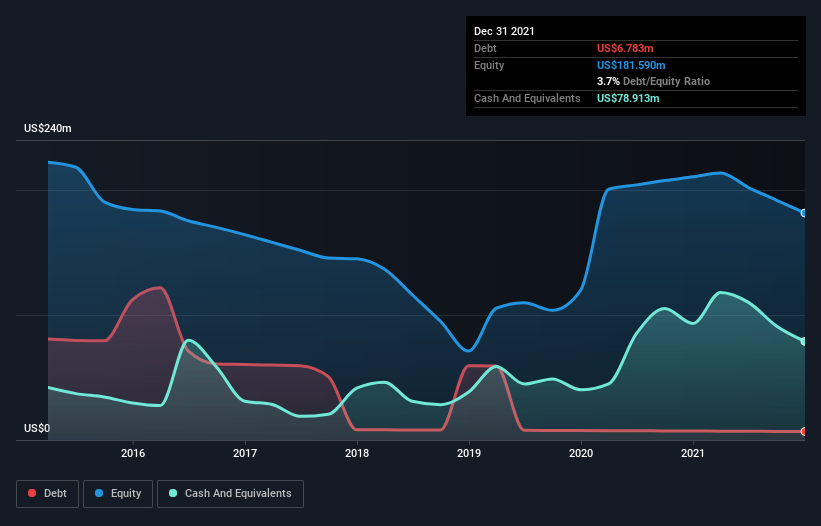
Howard Marks put it nicely when he said that, rather than worrying about share price volatility, 'The possibility of permanent loss is the risk I worry about... and every practical investor I know worries about.' So it seems the smart money knows that debt - which is usually involved in bankruptcies - is a very important factor, when you assess how risky a company is. We can see that AlerisLife Inc. (NASDAQ:ALR) does use debt in its business. But is this debt a concern to shareholders?
What Risk Does Debt Bring?
Debt is a tool to help businesses grow, but if a business is incapable of paying off its lenders, then it exists at their mercy. If things get really bad, the lenders can take control of the business. However, a more frequent (but still costly) occurrence is where a company must issue shares at bargain-basement prices, permanently diluting shareholders, just to shore up its balance sheet. Of course, the upside of debt is that it often represents cheap capital, especially when it replaces dilution in a company with the ability to reinvest at high rates of return. When we examine debt levels, we first consider both cash and debt levels, together.
See our latest analysis for AlerisLife
What Is AlerisLife's Net Debt?
The image below, which you can click on for greater detail, shows that AlerisLife had debt of US$6.78m at the end of December 2021, a reduction from US$7.17m over a year. However, its balance sheet shows it holds US$78.9m in cash, so it actually has US$72.1m net cash.

A Look At AlerisLife's Liabilities
Zooming in on the latest balance sheet data, we can see that AlerisLife had liabilities of US$140.9m due within 12 months and liabilities of US$53.8m due beyond that. On the other hand, it had cash of US$78.9m and US$50.9m worth of receivables due within a year. So its liabilities total US$64.9m more than the combination of its cash and short-term receivables.
This deficit is considerable relative to its market capitalization of US$81.5m, so it does suggest shareholders should keep an eye on AlerisLife's use of debt. Should its lenders demand that it shore up the balance sheet, shareholders would likely face severe dilution. While it does have liabilities worth noting, AlerisLife also has more cash than debt, so we're pretty confident it can manage its debt safely. The balance sheet is clearly the area to focus on when you are analysing debt. But ultimately the future profitability of the business will decide if AlerisLife can strengthen its balance sheet over time. So if you want to see what the professionals think, you might find this free report on analyst profit forecasts to be interesting.
Over 12 months, AlerisLife made a loss at the EBIT level, and saw its revenue drop to US$180m, which is a fall of 19%. We would much prefer see growth.
So How Risky Is AlerisLife?
By their very nature companies that are losing money are more risky than those with a long history of profitability. And in the last year AlerisLife had an earnings before interest and tax (EBIT) loss, truth be told. And over the same period it saw negative free cash outflow of US$17m and booked a US$30m accounting loss. Given it only has net cash of US$72.1m, the company may need to raise more capital if it doesn't reach break-even soon. Summing up, we're a little skeptical of this one, as it seems fairly risky in the absence of free cashflow. When analysing debt levels, the balance sheet is the obvious place to start. But ultimately, every company can contain risks that exist outside of the balance sheet. For instance, we've identified 3 warning signs for AlerisLife that you should be aware of.
At the end of the day, it's often better to focus on companies that are free from net debt. You can access our special list of such companies (all with a track record of profit growth). It's free.
If you're looking to trade AlerisLife, open an account with the lowest-cost platform trusted by professionals, Interactive Brokers.
With clients in over 200 countries and territories, and access to 160 markets, IBKR lets you trade stocks, options, futures, forex, bonds and funds from a single integrated account.
Enjoy no hidden fees, no account minimums, and FX conversion rates as low as 0.03%, far better than what most brokers offer.
Sponsored ContentNew: Manage All Your Stock Portfolios in One Place
We've created the ultimate portfolio companion for stock investors, and it's free.
• Connect an unlimited number of Portfolios and see your total in one currency
• Be alerted to new Warning Signs or Risks via email or mobile
• Track the Fair Value of your stocks
Have feedback on this article? Concerned about the content? Get in touch with us directly. Alternatively, email editorial-team (at) simplywallst.com.
This article by Simply Wall St is general in nature. We provide commentary based on historical data and analyst forecasts only using an unbiased methodology and our articles are not intended to be financial advice. It does not constitute a recommendation to buy or sell any stock, and does not take account of your objectives, or your financial situation. We aim to bring you long-term focused analysis driven by fundamental data. Note that our analysis may not factor in the latest price-sensitive company announcements or qualitative material. Simply Wall St has no position in any stocks mentioned.
About NasdaqCM:ALR
AlerisLife
AlerisLife Inc. operates and manages senior living communities in the United States.
Adequate balance sheet and fair value.
Similar Companies
Market Insights
Community Narratives



